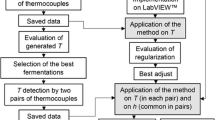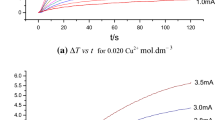Summary
A special temperature control system has been developed and applied to continuous measuring of the heat evolved during a fermentation process. In this system, the fermentation broth was overcooled by a given constant cooling water flow. The excess heat removed from the fermentor was then made up by an immersion electrical heater. The action of the temperature controller was precisely monitored as it varied in response to the amount of heat produced by the microbial activities.
The technique was used for determining the heat evolution byEscherichia coli grown on glucose. The ratio between quantities of total heat release and total oxygen consumption has been determined to be 0.556 MJ/mol O2.
The newly developed technique can be employed as an online sensor to monitor the microbial activities of either aerobic or anaerobic fermentation systems.
Similar content being viewed by others
Abbreviations
- Cc :
-
Heat capacity of cooling water (MJ/kg · °C)
- Cp :
-
Heat capacity (MJ/kg · °C)
- I:
-
Current of immersion heater (A)
- K:
-
Constant in Equation (2) (h)
- K α :
-
Constant in Equation (13) (m3 · h · °C/MJ)
- Qc :
-
Flow rate of cooling water (m3/h)
- \(\dot Q_{agi} \) :
-
Heat of agitation (MJ/m3 · h)
- \(\dot Q_{agi} \) :
-
Heat dissipated by the bubbling gas (MJ/m3 · h)
- \(\dot Q_{con} \) :
-
Heat removal by the action of controller (MJ/m3 · h)
- \(\dot Q_{ferm} \) :
-
Heat of fermentation (MJ/m3 · h)
- \(\dot Q_{surr} \) :
-
Heat loss to the surroundings (MJ/m3 · h)
- Qpass :
-
Constant average power dissipated by the immersion heater (MJ/m3 · h)
- \(\bar Q_{pass} \) :
-
Fluctuating power dissipated by the immersion heater (MJ/m3 · h)
- \(\tilde Q_{pss} \) :
-
Power dissipated by the immersion heater (MJ/m3 · h)
- T:
-
Temperature of fermentation broth (°C)
- \(\bar T\) :
-
Constant average temperature of fermentation broth (°C)
- \(\tilde T\) :
-
Fluctuating temperature of fermentation broth (°C)
- Ta :
-
Temperature of the ambient air (°C)
- Tc :
-
Inlet temperature of cooling water (°C)
- U1A1 :
-
Specific heat transfer coefficient for determination of heat loss to the surroundings (MJ/m3 · h · °C)
- U2A2 :
-
Specific heat transfer coefficient for cooling surfaces (MJ/m3 · h · °C)
- U3A3 :
-
Constant in Equation (16) (MJ/m3 · h · °C)
- V:
-
Voltage of immersion heater (V)
- VL :
-
Liquid volume (m3)
- OUR:
-
Oxygen uptake rate (mol O2/m3 · h)
- ΔHfo :
-
The ratio between the total heat release and the total oxygen uptake (MJ/mol O2)
- ϱc :
-
Density of cooling water (kg/m3)
- Γ:
-
Time constant defined in Equation (6) (h)
- ∑iMiCpi :
-
Heat capacity of system components (fermentation broth + fermentor jar + stainless steel) (MJ/m3 · °C)
References
Amundson NR, Kalman NR, Lapidus L (1960) Fundamental Ideas and Applications of Optimization Techniques in Design and Control. AIChE Special Lecture Notes, Cleveland, Ohio, USA
Battley EH (1960) A Theoretical Approach to the Study of the Thermo-Dynamic Growth ofSaccharomyces cerevisiae. Physiol Plantarum 13:674
Belaich JP, Senez JC, Murgier M (1968) Microcalorimetric Study of Glucose Permeation in Microbial Cells. J Bacteriol 95:1750
Cooney CL, Wang DIC, Mateles RI (1969) Measurement of Heat Evolution and Correlation with Oxygen Consumption during Microbial Growth. Biotechnol Bioeng 11:269
Eriksson R (1971) Design and Testing of a Flow Microcalorimeter for Studies of Aerobic Bacterial Growth. Pro. 1st Europ. Biophys Congr. IV:319, Wien Med Akad
Eriksson R, Holme T (1973) The Use of Microcalorimetry as An Analytical Tool for Microbial Processes. Biotech Bioeng Symp 4:581
Forrest WW (1961) Calorimeter for the Continuous Study of the Heat Production of Microbial Systems. J Sci Instru 38:143
Imanaka T, Aiba S (1976) A Convenient Method to Estimate the Rate of Heat Evolution in Fermentation. J Appl Chem Biotech 26:559
Luong JHT, Volesky B (1980) Determination of the Heat of Some Aerobic Fermentations. Can J Chem Eng 58:497
Luong JHT, Volesky B (1982) Indirect Determination of Biomass Concentration in Fermentation Processes. Can J Chem Eng 60:163
Minkevich IG, Eroshin VK (1973) Productivity and Heat Generation of Fermentation Under Oxygen Limitation. Folia Microbiol 13:376
Volesky B, Yerushalmi L, Luong JHT (1982) Metabolic Heat Relationship of Aerobic Yeast Respiration and Fermentation. J Chem Technol Biotechnol 32:650
Winzler RJ, Baumberger JP (1938) The Degradation of Energy in the Metabolism of Yeast Cells. J Cell Compar Physiol 12:183
Zabriskie DW, Humphrey AE (1978) Real Time Estimation of Aerobic Batch Fermentation Biomass Concentration by Component Balancing. AIChE J 24:138
Author information
Authors and Affiliations
Rights and permissions
About this article
Cite this article
Luong, J.H.T., Volesky, B. A new technique for continuous measurement of the heat of fermentation. European J. Appl. Microbiol. Biotechnol. 16, 28–34 (1982). https://doi.org/10.1007/BF01008239
Received:
Issue Date:
DOI: https://doi.org/10.1007/BF01008239




